
In order to fully answer that question and to help you make the right decision when choosing the gem that is best for you we created this page on gem cutting styles and their impact on the gem’s appearance. To start we have a short video below to help you understand cut quality, why it is important and how to tell a well cut gem from a poorly cut one. Then we go on to explain some of the terms we use in the gem trade to describe a gem’s optical qualities which the layman often lumps together under the terms “sparkle” or “brightness” and how all this translates into helping you find the gem you will love the most!
The most important factor when it comes to brilliance and "sparkle" is the quality of the gem cutting. Here is a short video tutorial we made showing the difference between good and bad gemstone cutting.
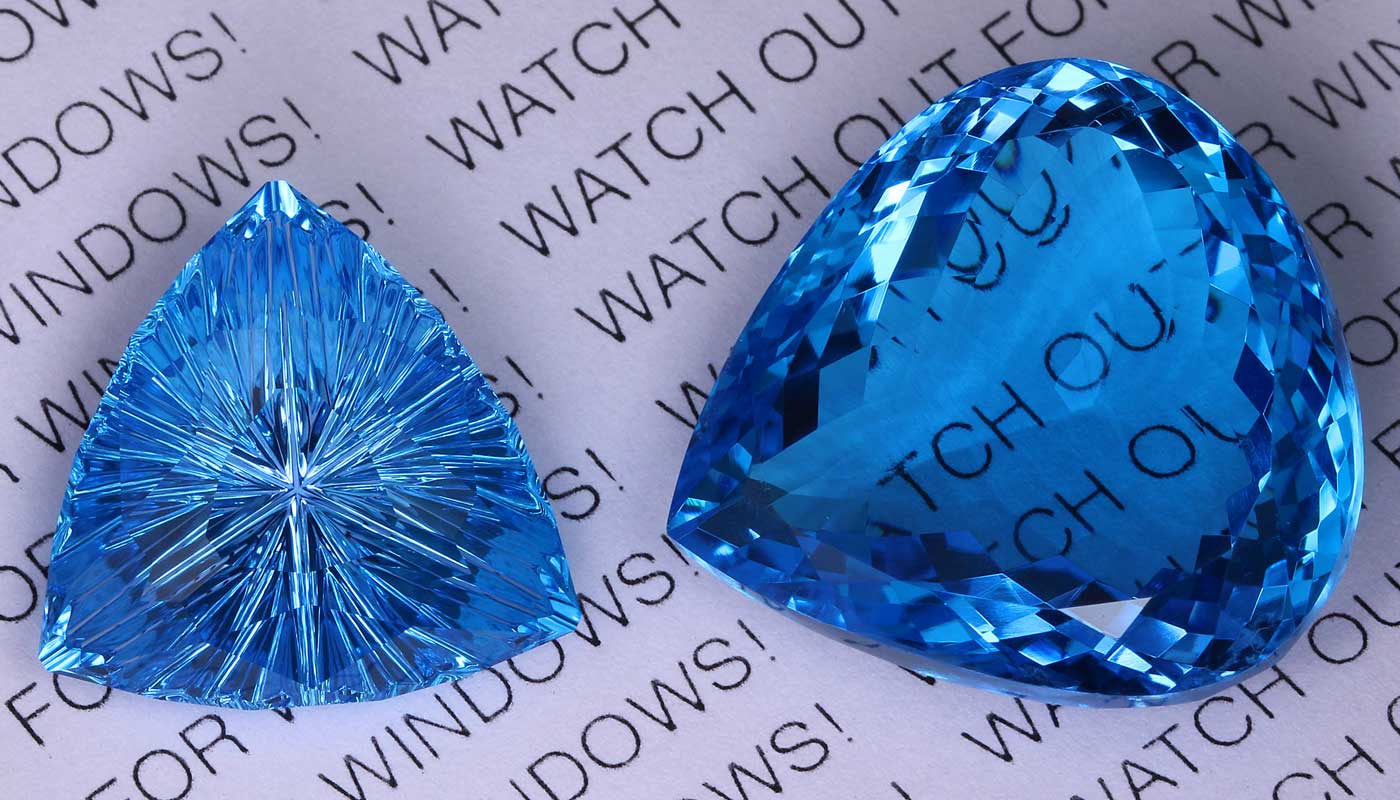
Another example of the difference good cutting makes on brilliance. In the image above both gems are blue topaz, but the gem on the left is well cut in our StarBrite™ cutting style and the gem on the right is poorly cut and "windowed" due to using incorrect angles on the bottom which results in a large "dead" area in the middle which doesn’t have brilliance and you can actually read through. See how much more light is coming back out of the gem on the left? We mention quality of cut in as it is relevant to this page, but the main goal of this article is to help you choose between two or more WELL CUT gems to know which will appeal to you most.
If you would like to see them we also have other informative videos on gem cuts and the differences in beauty and value this makes when selecting a gemstone.
Now to explain some of the terms that it is important to understand:
In layman's terms this is how bright the gem looks to the eye when both the gem and the viewer are stationary, this "perceived brilliance" has to do both with the amount of light reflected by the gem to the eye and the contrast pattern created by the cut. (The eye perceives a gem with strong contrast of light and dark reflections as brighter than a gem that reflects the same amount of light but does not have much contrast between reflections.)
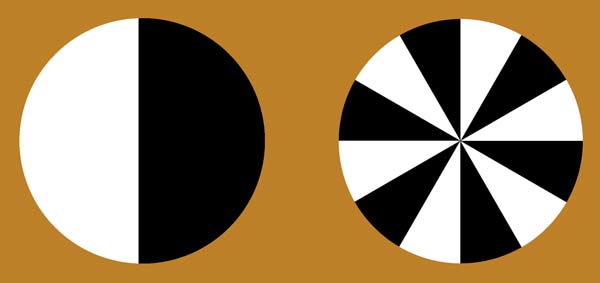
Illustrating the impact of contrast on perceived brilliance: Which circle looks brighter to you? People almost universally choose the circle on the right as the most brilliant, even though the ratio of white to black in the two circles is identical (50/50). The difference is the distribution of these light and dark areas, since in the circle on the right they are more broken up it looks "brighter" or more brilliant to the human eye.
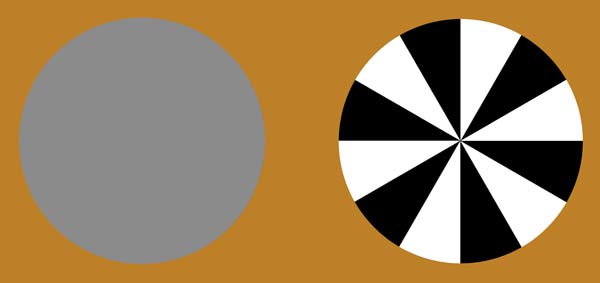
Interestingly (to us nerdy types at least) a gray circle with 50% saturation, even though it still has the same amount of white and black, will look less bright to the human eye than either of these prior circles with separate white and black sections. This is because it lacks contrast. To a machine measuring system ALL these example circles would be equally “bright” (because they have an equal mix of white and black).
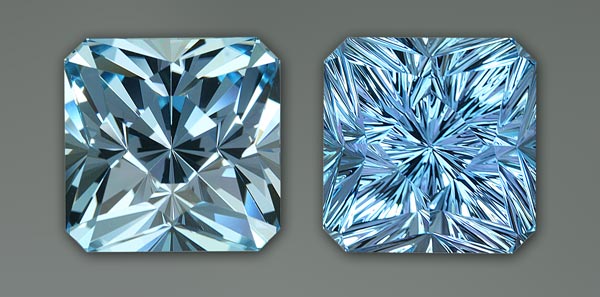
What does all that mean in practice? It means that gems with a cut that has a more complex brilliance pattern often will appear more brilliant to the human eye even if they actually reflect the same amount of light. The picture above has two blue topaz of the same shape, the one on the left is a precision cut flat faceted gem and the one on the right is a concave faceted gem. (Both gems have our cutting.) To most people the gem on the left with concave facets will look more "brilliant". That is because its light and dark reflections are divided up by the curved facets on the pavilion of the gem into many smaller reflections. This breaks up the brilliance pattern into a far more complex and bright looking whole. See how the dark and light reflections are each much smaller in the concave faceted gem? Even though the ratio of light and dark reflections take up a roughly similar percentage of the total area of the gem the brilliance pattern is very different. (I find that this preference for an extremely complex brilliance pattern is not universal though, some people will prefer the larger brilliance reflection pattern like the gem on the left.)
As you can see from this video and illustrations, cut design AND cut quality have a significant impact on perceived brilliance. If you are buying a gem from us you can be confident that it is well cut, but there are also other factors that make many people’s choice come down to one of personal taste between two well cut gems of ours with different designs or gemstone cutting techniques. Read on to learn more about these subtleties.
When people use the terms "sparkle" or "lively" when referring to a gemstone, what they usually mean is a combination of brilliance (stationary brightness) and scintillation. Scintillation is the light moving and glinting off different facets INSIDE the gem as the gem is moved around. (Light glinting off surface facets is simple reflection and not what we are referring to when we talk about scintillation.) To observe scintillation either the gem, the light source, or the viewer must move at least somewhat. A still picture on the internet can show a gem that looks very "bright" and illustrate the brilliance of the gem under certain lighting conditions, but it cannot show scintillation because it is by definition static (not moving). (This is one reason why many of our gems now also have videos, to show them with movement.)
A short video tutorial explaining the difference between brilliance, scintillation and which cut types tend to best show each of them.
Have you seen those rainbow colors coming out of a white diamond? Or those flashes of red, blue and green coming out of a cognac or champagne color zircon? That is dispersion! Dispersion is when white light is broken up into its spectral colors (kind of like a prism does) before being reflected to the eye. Dispersion depends a LOT on the gem material, some kinds of gems just have more dispersion than others. Sphene for example has amazing dispersion! Even though this property is to some extent inherent in the gem material the cutting style can emphasize or hide this phenomenon. In most cases dispersive gems look better with flat faceted cutting styles, also a taller crown and smaller table along with a good polish and correct pavilion angles can accentuate the dispersion even further. (Some kinds of gem materials simply do not have much dispersion no matter what the cut is, so this isn't a big factor on those varieties of gemstones.)
A list of the gems we work with which show significant dispersion, from most dispersion to least, are sphene, zircon, Mali garnet and to a lesser extent, tanzanite.
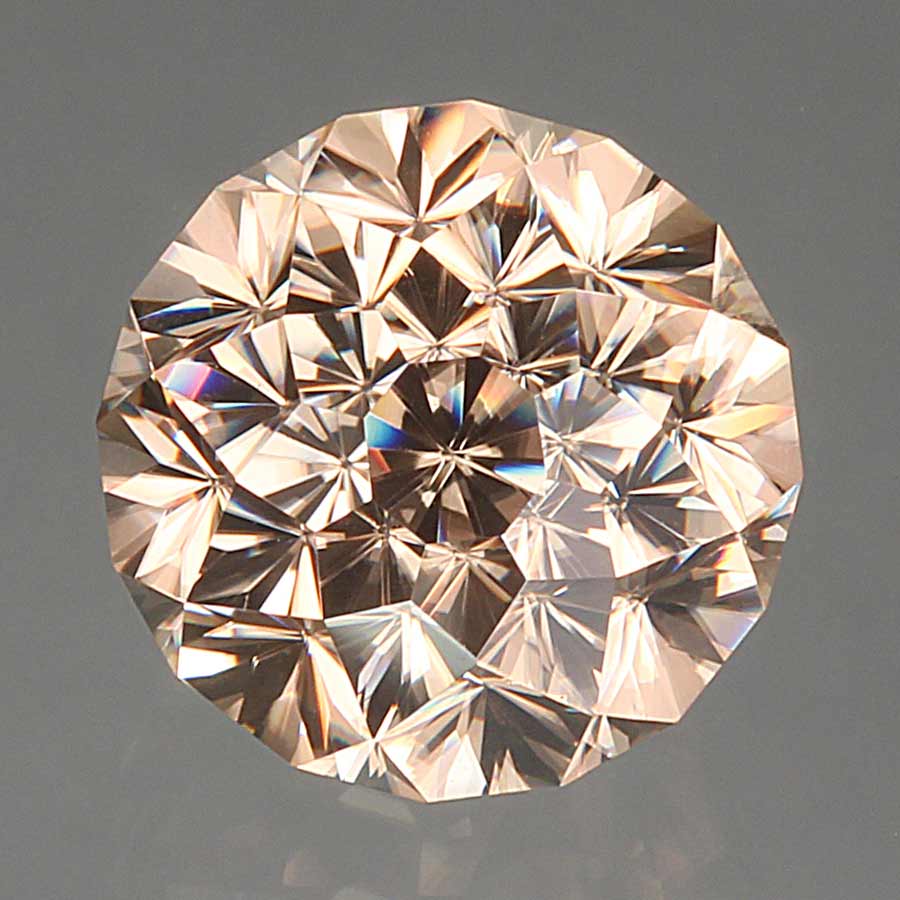
Natural zircon can be very dispersive if well cut.
See the flashes of blue, pink, purple and yellow in an otherwise light tan colored gemstone? These colorful flashes are not the same as the body color of the gem but instead are caused by the white light being broken up (dispersed) into its spectral colors like a prism.
Note: Zircon is a naturally mined gem that should not be confused with the man-made gem cubic zirconia.
Photo credit: SunBurst™ cut champagne color zircon by John Dyer Gems.
As a gem is tipped the angle the bottom facets are being viewed at changes and even with a well cut gem with flat facets "tilt windowing" will almost always occur at some tilt angle, this can be as little as 10 degrees of tilt or as much as 20 degrees of tilt depending on the type of material and the cutting style. Tilt windowing does not mean the entire gem will window, but the side that you have effectively lowered the angle on by tilting the gem will allow light and your line of sight to pass through. The lowest angled facets (nearest the culet, which is the point on the bottom of the gem) will window or dump light the soonest as you tilt it. This means that cuts with many rows of progressively deeper facets show less tilt windowing and more scintillation, but (with the exception of the trillion shape) these cuts with many rows of facets can be slightly less bright (less brilliance) since a higher percentage of facets are at a greater angle than the one which is optimal to reflect light directly back to the viewer. So as with many things you have a trade off, most gems with many rows of facets will give you more tilt brilliance and more scintillation in exchange for a little less brilliance.
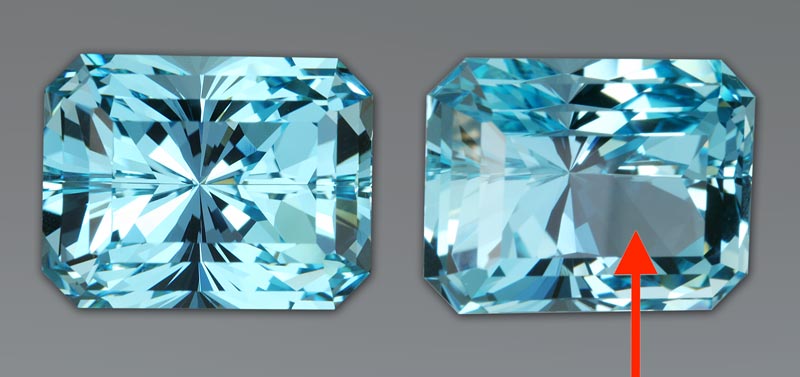
Tilt windowing demonstration
In this photo of an aquamarine can you see how even with a well cut flat faceted gem as the gem tilts (image on the right) it gets to a certain point where you can see through one portion of it to the gray background? Interestingly it also matters which direction the gem is tilted, in this example I chose a "bad" tilt direction for this cut to illustrate my point, if the gem were rocked from end to end it would tilt window less.
Some things that help reduce tilt windowing are a smaller table facet size, designs with multiple rows of facets on the pavilion at increasingly deeper angles and cutting the main pavilion facets using slightly deeper angles. All of these will have some impact on brilliance though, so finding the right balance is part of the art of gemstone cutting. Understanding all this will also help you understand the gem you should select and also why it is that to get some things you like (more scintillation for example) there are certain other factors you will need to accept.
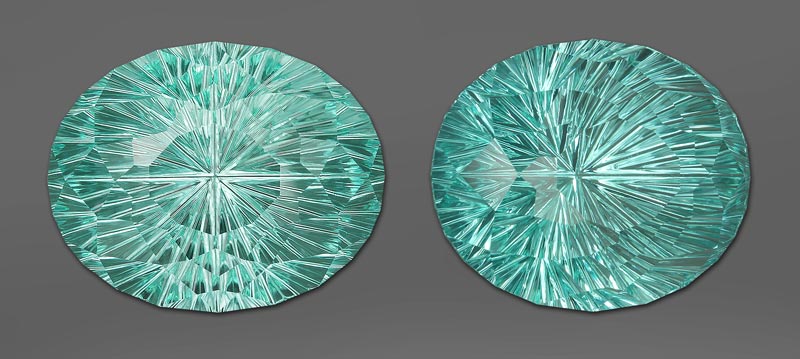
StarBrite™ style cutting reduces tilt windowing a LOT
In this photo of a 63 carat Paraiba type tourmaline from Mozambique can you see how even when tilted at an extreme angle (on the right) the StarBrite™ cutting style reduces tilt windowing to the point of almost eliminating it. The trade off in this case is the loss of some scintillation as we talked about in our video on scintillation versus brilliance. But still, this resistance to tilt windowing is a major benefit of this cutting style.
Since in reality most people mean a combination of brilliance, scintillation, dispersion and tilt brilliance when they want a "sparkly" or "lively" gem, finding out which of these factors are the most important to you can help guide your final choice of what kind of gem and what style of cut to buy.
For example, Concave and StarBrite™ style cuts will usually have a more brilliant look at any specific time than a flat faceted cut. (Because they have both good light return and a more complex brilliance contrast pattern.) However, because the concave and StarBrite™ cutting styles distribute the light very evenly around the gem all the time and the pavilion facet surfaces are not flat they do not have much "scintillation" which is when the light jumps from one facet to another and it looks "different" as you move it around. These cutting styles will usually change very little as the gem is moved, but look bright always. Some people LOVE these cutting styles and there are also those who prefer a flat faceted gem since their eye prefers scintillation to static brilliance.
Another consideration is that the StarBrite™ cut is awesome when it comes to tilt brilliance. You can radically tilt the gem and get almost no tilt windowing due to the special grooving cutting technique on the pavilion of the gem. The Concave cut also reduces “tilt windowing” by several degrees as the curves of each facet increase the angle slightly relative to a flat faceted gem.
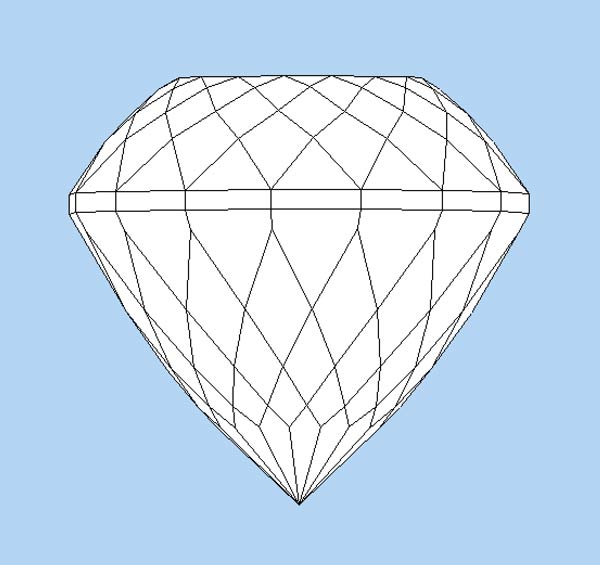
Many rows of facets give scintillation but make a gem deeper.
There is a minimum angle gems can be cut at to reflect light, that means that if a gem has multiple rows on the pavilion (bottom) the bottom row cannot be any shallower than the minimum angle for that material. Then each following row must be at a progressively steeper angle so it results in a deeper gem than a gem with only one or two rows of facets would be. The Portuguese cutting style pictured here is a good example of that.
Photo credit: Portuguese style cut rendering
Another advantage of the StarBrite™ style of cut is that the gem can be cut very shallowly and still be brilliant. When this is the case it allows you to set the gem much lower in a ring (if the ring is designed to take advantage of this) so the gem gets less beat up while it is worn, snags on less things and allows the wearer to slip it inside gloves if climate or profession require the use of gloves. Another advantage to a shallower gem is that since you pay per carat for the gem you will get a visually larger sized gem if the gem is does not have a deep bottom. So a shallow two carat gemstone can look the same size as a deep three carat gem in many cases and cost a lot less.
Always pay close attention to the MM size when buying a gem, it is a far more accurate indication of visual size than carat weight is due to how much the depth of different cuts can vary.
Also watch the mm depth to know how deep the gem is proportionally to the length and width.
The primary benefit of flat faceted gem cuts is greater scintillation (and also dispersion if the gem material you like has a lot of dispersion). If you are a scintillation addict then my flat faceted Super Trillion™ cut is probably the best thing that I know of in that regards but it is slightly deep due to having many rows of facets on the bottom. A trillion shape is very brilliant due to the optics of a "corner cube," (which allows it to break the rule about cuts with many rows of facets being less brilliant) and the Super Trillion™ has a lot of small facets which makes light have a lot of different facets to jump around on producing tons of scintillation. It is also the most brilliant flat faceted cut that we do.
Radiant style or brilliant style cuts and other cuts with a lot of small flat facets are also usually good for scintillation if the gem is well cut and offer other popular shapes for those who don’t love a trillion shaped gem, but will have a bit less scintillation than the Super Trillion™. Another flat faceted cut with great scintillation is a “Portuguese” style cut, but as with any cut with many rows of small facets (which help give the light more surfaces to reflect off and also reduce tilt windowing due to each tier of facets being at a progressively steeper angle) the Portuguese style cuts tend to be deep.
If you are considering purchasing a relatively deep gem cutting style for a ring take into account that the larger the gem is the more how deep it is will matter. A 5mm gem with 100% depth ratio will still only be 5mm deep, a 20mm gem with a 100% depth ration will be 20mm deep, and as a result would be far less practical for a ring that is worn frequently than the same cut in a much smaller gem.
The other thing some people like about flat faceting is that it has a more "classical" or "traditional" look which some prefer.
We hope this has helped you get a much better understanding of what makes a gem beautiful and what are the pros and cons of each style of gemstone cutting.